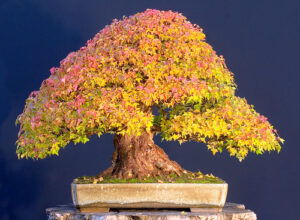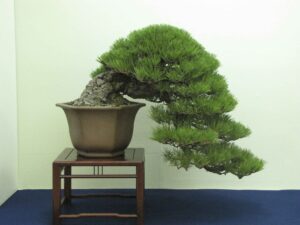Fuji (Wisteria)

In gardens, it is often used to grow over pergolas or facades. Several cultivars have different flower colors, like white, pink, and dark purple. The most common species for bonsai are the Chinese Wisteria (Wisteria sinensis) and the Japanese Wisteria (Wisteria floribunda) which produces the longest flower clusters. The long velvety seed pods can literally explode and catapult their seeds out when they get ripe. Seed pods and seeds are poisonous.
Most Fuji wisteria bonsai are of medium or large size because the long flower clusters need some height to hang from. They are very well suited for bonsai, but their special feature is the flowers. After flowering, the trunk and branches are hidden under long leaves and proliferating tendrils, and then the wisteria returns to the second row in the bonsai garden.
You always want to prune your tree in the spring or early summer before new growth starts. If you wait till later, it is nearly impossible for you to tell how old the branches are and if it’s the right time to prune them. When taking off leaves, make sure you are doing it from the bottom up instead of the top down. So start at the bottom and gradually remove all the old leaves until you only have new ones left.
It is a popular choice for many beginners because of its beautiful flowers and because it’s very easy to take care of.

Wisteria needs much attention and pruning to control its vigorous growing pattern. A lot of patience is required, but the reward of a great Bonsai tree will be well worth it.
What makes this tree so interesting is its flower season. After a little while, it will bloom lots and lots of flowers that hang down from the branches! However, this process takes at least four years before you see any flowers. But once it does blossom flowers, they’ll be everywhere! And what makes this even better for a beginner is that it’s also one of the most popular Bonsai trees around!
Cuttings: You can propagate Fuji from cuttings. You must take the cuttings from the soft wood. The soft wood is the green branches that have not formed the woody bark yet. Cuttings must be up to six inches long, and you must cut them diagonally where you want the roots to develop. The best time to propagate softwood cuttings is during spring. Dip the base of the cutting in rooting gel or powder, and plant in well-drained soil. Take a few cuttings, as the success rate is not guaranteed. Rooting is also better in soil than in water.
Fuji Wisteria doesn’t like its roots to stay wet. Make sure that you have well-drained soil mixed with compost with enough nutrients. The size of the container you want to use must match the size of the tree. Have some wire handy to anchor the Wisteria to the container.
It can make an exceptional Bonsai tree. You need patience and willingness to spend more time on the tree than usual. It will need a lot of pruning, watering, and repotting to keep it looking healthy. Believe me that you will be rewarded for your perseverance. The masses of purple or other color flowers are a picture to behold. Even in winter, the gnarled woody trunk and naked branches make a beautiful Bonsai tree.
Sources



